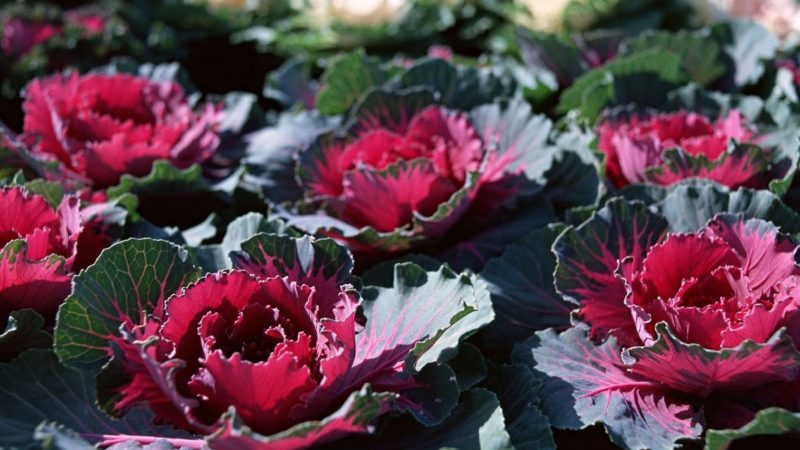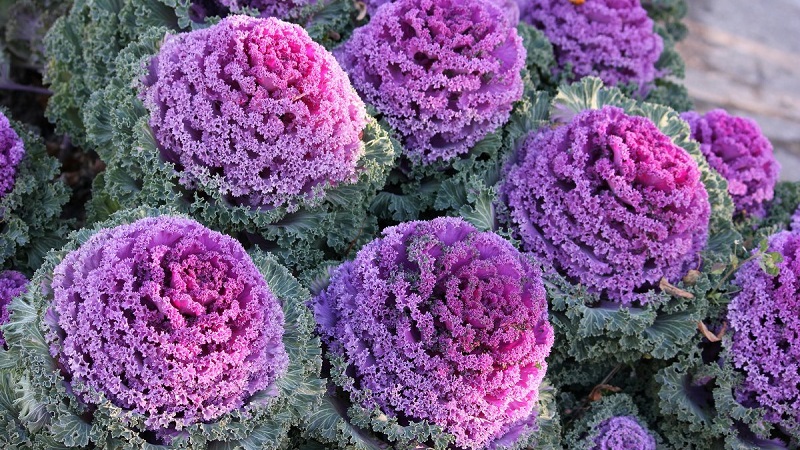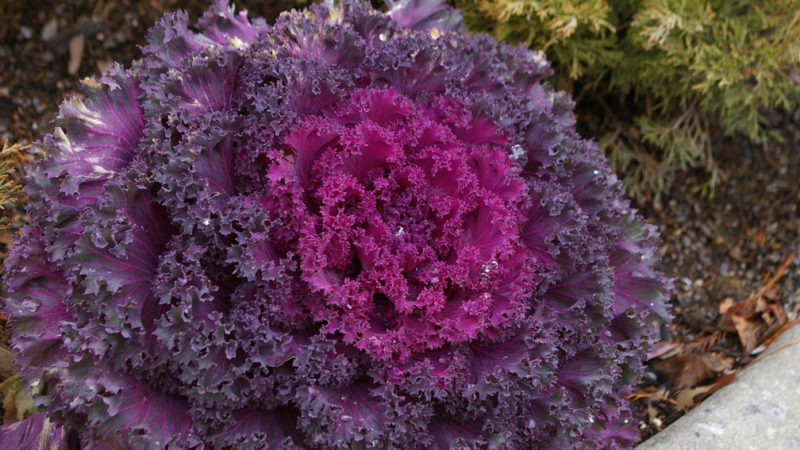Is ornamental cabbage edible
Ornamental cabbage is an unpretentious exotic plant. Bright, colorful inflorescences adorn plots, dachas and front gardens on gloomy autumn days. From the article you will find out whether ornamental cabbage can be eaten, how it is useful and how it is used.
The content of the article
Is it ok to eat ornamental cabbage, is it edible or not?

Ornamental cabbage (Brassica oleracea var. Acephala) is a type of headless cabbage. The herbaceous biennial is grown as an annual plant. Belongs to the huge family of Cruciferous (Brassicaceae).
The wild plants of the Mediterranean coast are considered the progenitors. Decorative varieties were bred in Japan, and later became widespread throughout Europe and Asia.
Cabbage is subdivided into kale and cabbage.
Leafy varieties are distinguished by feathery corrugated leaves, openwork fringe. Heads have a rounded leaf blade.
Leaves, depending on the variety, are white, purple, burgundy, greenish. Different shades are often mixed in one inflorescence.
Feature - they quickly build up green mass and throw out elongated peduncles. In cool weather, starting from the end of August, when the night temperature drops to + 10 ... + 13 ° C, the plant becomes especially bright due to specific anthocyanin pigments. In autumn, the color of the leaves becomes colorful and rich, the first frosts are not scary for her.
It is in the autumn that edible indoles are synthesized in the leaves of ornamental cabbage. These are aromatic compounds, natural bioactive substances, glucosinolates of cruciferous crops.
All varieties of ornamental cabbage are eaten. It is believed that leafy varieties are tastier and more tender. The plant is classified as a vegetative vegetable that is not inferior in chemical composition and nutritional value to onions, garlic, spinach, sorrel, etc.
Reference. Vegetative vegetables use stems, leaves, bulbs and other vegetative organs for food, but not fruits.
What vitamins contain

Organic compounds per 100 g:
- 10-21% (depending on the variety) of dry matter;
- up to 6% sugar;
- 0.6% starch;
- 1.5-1.8% dietary fiber;
- up to 3.5 crude protein.
The fiber content in ornamental cabbage is 2 times higher than in white cabbage, Peking cabbage, kohlrabi and broccoli.
The complex of vitamins per 100 g includes:
- 150 mg - C;
- more than 5 mg - carotene;
- 0.18 mg - B1;
- 0.02 mg - B2;
- 0.06 mg - B6;
- 0.07 mg - PP;
- 100-150 mcg - K.
In small amounts, ornamental cabbage contains a rare vitamin U, which is not produced by the body and promotes the healing of wounds and damage to the mucous membrane of the digestive tract. It can only be obtained from raw vegetables.
100 g of raw material of ornamental cabbage contains minerals:
- 350 mg - potassium;
- 150-200 mg - calcium;
- up to 60 mg - phosphorus;
- 15 mg - sodium;
- more than 4 mg - iron;
- 35-40 mg - magnesium.
There are more than 16 types of amino acids in ornamental cabbage:
- lysine;
- tryptophan;
- tyrosine;
- methionine;
- histidine, etc.
The composition of enzymes that perform oxidative and degrading functions in the body:
- ascorbinase;
- peroxidase;
- cytochrome oxidase;
- amylase;
- sucrose;
- hemicellulose.
Read also:
Ornamental cabbage: culture features
What is useful

Ornamental cabbage is a record holder by the amount of ascorbic acid.Vitamin C is a natural immunomodulator and immune stimulant that protects the body from bacteria and viruses.
Vitamin K, responsible for the transport of calcium, directly affects blood clotting and its composition.
Ornamental cabbage is an excellent antioxidant.
Indigestible fiber gently cleanse the intestines, improve its peristalsis, relieve constipation. Vitamin U has an antihistamine effect, removes salts of heavy metals, heals and restores the mucous membrane of the digestive tract.
Mineral salts and trace elements replenish the daily human need for nutrients. Supports all vital body functions. They strengthen the skeleton, participate in metabolic processes, and affect hormonal levels.
Potassium stimulates the transmission of nerve impulses, maintains the acid-base balance of the blood, provides carbohydrate metabolism in the body, prevents muscle cramps and spasms.
Calcium regulates blood pressure and lowers the level of harmful cholesterol, affects the elasticity of blood vessels, resists atherosclerosis, the formation of blood clots. Ornamental cabbage is useful for strengthening bones, tissue regeneration, kidney and excretory system.
Essential and non-essential amino acids - a building protein material for muscle tissue. They improve the condition of the skin and hair, increase efficiency and endurance, and reduce fatigue. Leucine, for example, promotes fat burning and lowers blood sugar. Tryptophan regulates appetite, prevents insomnia. Amino acids affect the emotional state - reduce the level of anxiety, resist depressive disorders.
Important. The degrading enzymes present in ornamental cabbage eliminate the deficiency of the enzymatic system, optimize the digestion process at all stages. Eliminate the feeling of heaviness (when overeating), eliminate bloating, improve bowel function.
Benefits for people in general

The main purpose of ornamental cabbage is the decoration and design of a garden, a summer cottage, a front garden... It is planted along paths, on alpine slides, multi-level mixborders, multi-row mixed flower beds, choosing according to height and color scheme.
In apartments it grows well at cool temperatures on balconies, loggias, mini-greenhouses as a pot culture. In the house and in the country, culture is planted in flowerpots, placing them at the entrance, along the perimeter of the stairs.
The plant is planted in open sunny areas in May. The culture does not require special conditions and care. Moderate watering, mineral and organic fertilizing during the growing season and sufficient lighting - and the flower bed will be full of bright colors until late autumn.
The most popular and popular varieties of ornamental cabbage:
- Tokyo - differs in pale green wavy extreme and contrasting inner leaves;
- Osaka grows up to 50-60 cm in height, the diameter of the rosette is up to 50 cm;
- Nagoya - forms a large inflorescence of a bright red hue;
- The tongue of a lark produces a stem up to 1-1.2 m in height, leaf plates are of a rich dark green color.
On mixed plantings and in a cut in bouquets, ornamental cabbage is in harmony with large red cannes, purple septenchins, cereals, chrysanthemums.
Healing properties

The edible indoles contained in ornamental cabbage varieties have unique properties:
- prevent and limit the accumulation of carcinogens-aflatoxins in the body,
- resist the appearance of cancer cells,
- protect DNA from negative environmental influences,
- prevent inflammation of the prostate gland.
In the journal "Problems of Biological and Medicinal Chemistry" for 2008, the results of the study of food indoles were announced. It has been proven that these substances protect cell membranes from destruction, resist breast cancer, mastopathy, formations of fibromatous nodes in the uterus and breast.
Vegetable glycosides-anthocyanins are found in the juice of the leaves of ornamental cabbage. These are useful natural supplements. They protect against ultraviolet rays, free radicals, remove toxins and toxins.
Plant pigments neutralize bacterial infections, counteract diabetes mellitus and endocrine pathologies. Reduces the risk of developing cancer in the case of a hereditary predisposition.
Fact. Due to the high content of antioxidants, ornamental cabbage is recommended to be included in the diet for those who actively use mobile communications.
Dietary fiber gently cleanses the intestines and normalizes its microflora, helps to reduce body weight.
How to eat
Farmers and summer residents are advised to add leaves to the diet in late autumn... At the beginning of winter they are "extracted" from under the snow, then kept in cold water for 10-15 minutes, washed and added to food. A vitamin salad or a side dish with cabbage leaves will diversify your lunch or dinner.
Red and white subspecies of the Nagoya variety are usually used for garnish. Delicate leaves do not require long heat treatment.
Chidori variety with wavy fringes are used for food after the first frost. The bitterness and hardness of the sheet plate is gone.

Ornamental cabbage is stewed, baked, added to omelets. When serving, sprinkle generously with fresh herbs and drizzle with olive oil. Stew for no more than 2-4 minutes so that the leaves do not lose color and nutritional properties.
The leaves are added to puree soup, vegetable stews, sauces. Used for making stuffed cabbage and dolma. They go well with rice.
For diet salads, cocktail mixes, vegetable fresh and smoothies take young leaves. They do not need to be soaked, scalded with boiling water... Vitamins and mineral salts are preserved in their entirety.
Vitamins are also preserved when frozen - the leaves are perfectly stored in the freezer and do not lose nutritional value for 6-10 months.
Read also:
Conclusion
All varieties of ornamental cabbage are suitable for human consumption. In terms of chemical composition, the plant is not inferior to garden species - white cabbage, Peking, broccoli, colored, kohlrabi, etc. Unique plant components - fiber, anthocyanins, dietary indoles - absorb toxins, reduce the risk of cancer, are beneficial for male and female health.
Ornamental cabbage is recommended for people with diabetes mellitus, pathologies of the digestive tract, has no age restrictions and contraindications. It is a natural immunostimulant and immunomodulator. Replenishes vitamin deficiencies in the autumn-winter period, protects against depression and loss of energy.